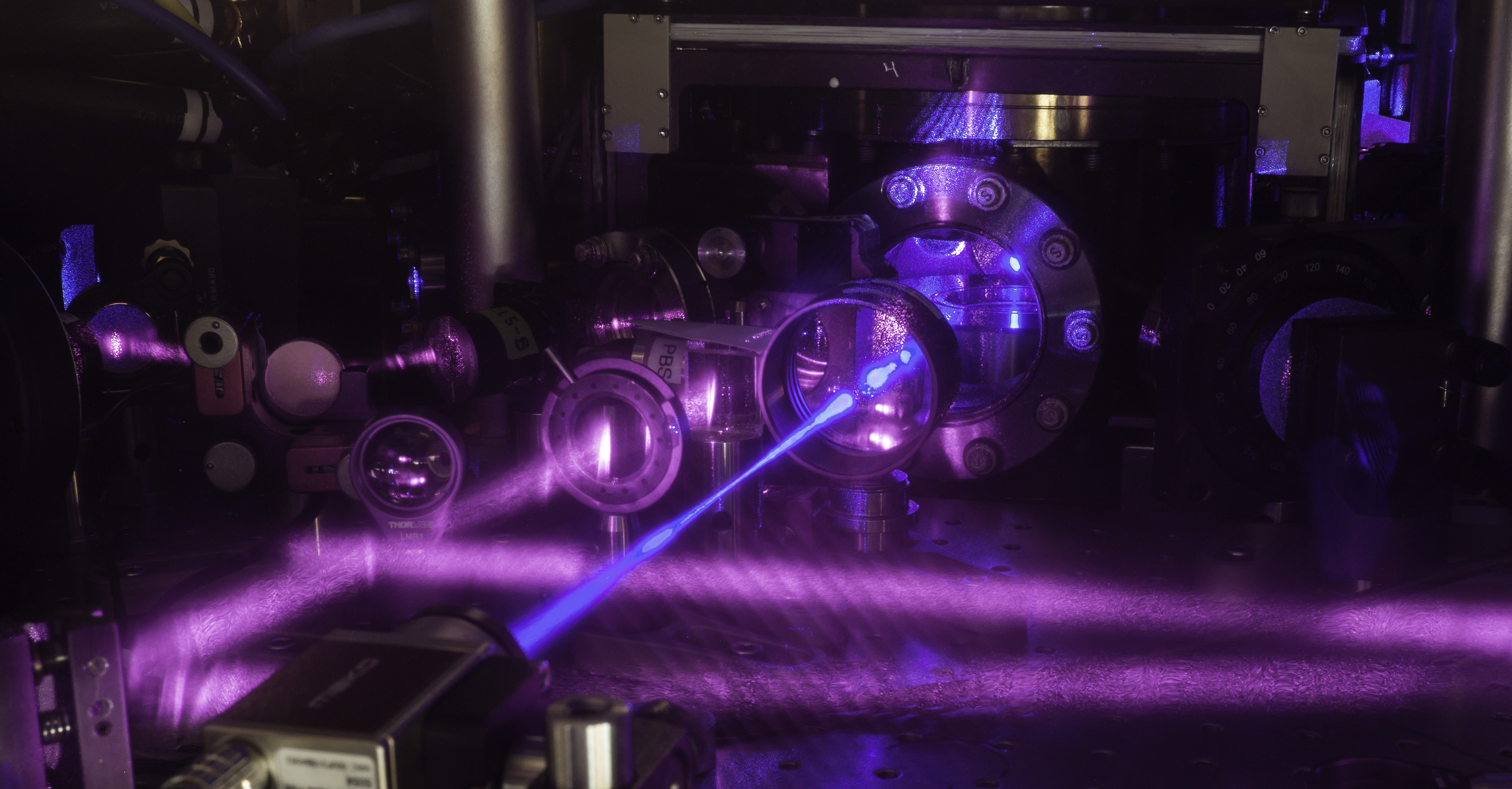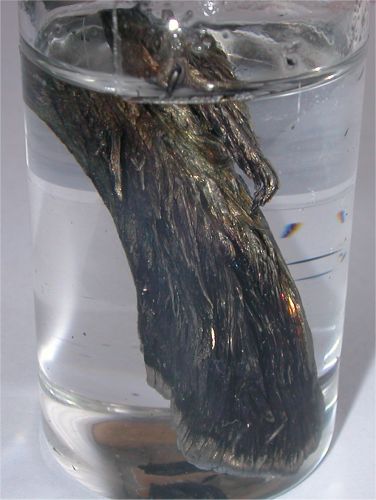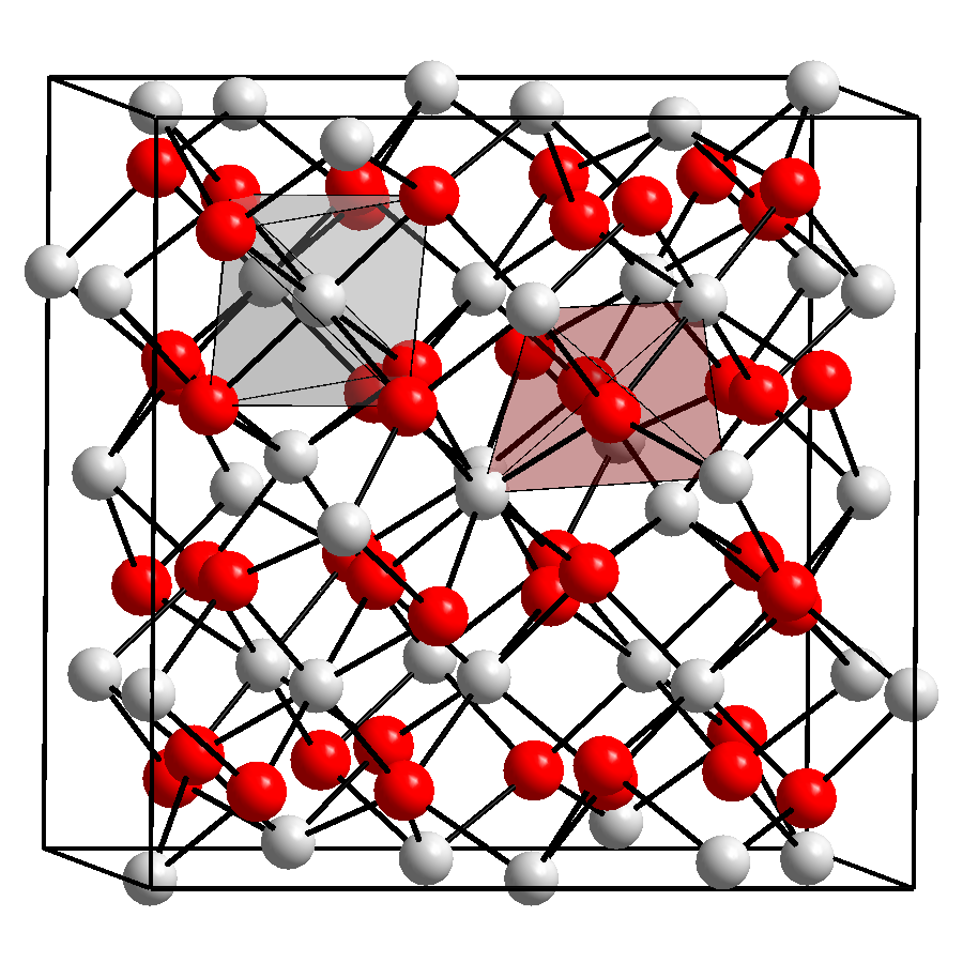|
Optical Clock
Optical clocks are the most precise instruments ever developed. The precision of a clock is the smallest unit of time it can measure. Optical clocks reach record-breaking precision by counting oscillations of visible light, which oscillates up to 750 quadrillion times a second. By counting these oscillations, one can divide a second into 750 quadrillion pieces. Each of these pieces is roughly one femtosecond. This means that by counting oscillations of light, one can be certain of the time to within one femtosecond. Oscillations of light are counted using a frequency comb, and stabilized using atoms. Optical clocks are a subset of atomic clocks, which typically measure microwaves. However, microwaves oscillate around 100,000 times slower than visible light. For this reason, optical clocks are expected to replace microwave caesium clocks as the Caesium standard, definition of the second. Several elements have been used in optical clocks, including magnesium, Aluminium, aluminum, pot ... [...More Info...] [...Related Items...] OR: [Wikipedia] [Google] [Baidu] |
Frequency Comb
A frequency comb or spectral comb is a spectrum made of discrete and regularly spaced spectral lines. In optics, a frequency comb can be generated by certain laser sources. A number of mechanisms exist for obtaining an optical frequency comb, including periodic modulation (in amplitude and/or phase) of a continuous-wave laser, four-wave mixing in nonlinear media, or stabilization of the pulse train generated by a mode-locked laser. Much work has been devoted to this last mechanism, which was developed around the turn of the 21st century and ultimately led to one half of the Nobel Prize in Physics being shared by John L. Hall and Theodor W. Hänsch in 2005. The frequency domain representation of a perfect frequency comb is like a Dirac comb, a series of delta functions spaced according to : f_n = f_0 + n\,f_r, where n is an integer, f_r is the comb tooth spacing (equal to the mode-locked laser's repetition rate or, alternatively, the modulation frequency), and f_0 is the ... [...More Info...] [...Related Items...] OR: [Wikipedia] [Google] [Baidu] |
Optical Lattice
An optical lattice is formed by the Interference (wave propagation), interference of counter-propagating laser beams, creating a spatially periodic intensity pattern. The resulting periodic scalar potential, potential may trap neutral atoms via the Stark shift. Atoms are cooled and congregate at the potential extrema (at maxima for blue-detuned lattices, and minima for red-detuned lattices). The resulting arrangement of trapped atoms resembles a crystal lattice and can be used for Quantum simulator, quantum simulation. Atoms trapped in the optical lattice may move due to quantum tunneling, even if the potential well depth of the lattice points exceeds the kinetic energy of the atoms, which is similar to the electrons in a Electrical conductor, conductor. However, a superfluid–Mott insulator transition may occur, if the interaction energy between the atoms becomes larger than the hopping energy when the well depth is very large. In the Mott insulator phase, atoms will be trappe ... [...More Info...] [...Related Items...] OR: [Wikipedia] [Google] [Baidu] |
Calcium
Calcium is a chemical element; it has symbol Ca and atomic number 20. As an alkaline earth metal, calcium is a reactive metal that forms a dark oxide-nitride layer when exposed to air. Its physical and chemical properties are most similar to its heavier homologues strontium and barium. It is the fifth most abundant element in Earth's crust, and the third most abundant metal, after iron and aluminium. The most common calcium compound on Earth is calcium carbonate, found in limestone and the fossils of early sea life; gypsum, anhydrite, fluorite, and apatite are also sources of calcium. The name comes from Latin ''calx'' " lime", which was obtained from heating limestone. Some calcium compounds were known to the ancients, though their chemistry was unknown until the seventeenth century. Pure calcium was isolated in 1808 via electrolysis of its oxide by Humphry Davy, who named the element. Calcium compounds are widely used in many industries: in foods and pharmaceuticals for ... [...More Info...] [...Related Items...] OR: [Wikipedia] [Google] [Baidu] |
Magnesium
Magnesium is a chemical element; it has Symbol (chemistry), symbol Mg and atomic number 12. It is a shiny gray metal having a low density, low melting point and high chemical reactivity. Like the other alkaline earth metals (group 2 of the periodic table), it occurs naturally only in combination with other elements and almost always has an oxidation state of +2. It reacts readily with air to form a thin Passivation (chemistry), passivation coating of magnesium oxide that inhibits further corrosion of the metal. The free metal burns with a brilliant-white light. The metal is obtained mainly by electrolysis of magnesium Salt (chemistry), salts obtained from brine. It is less dense than aluminium and is used primarily as a component in strong and lightweight magnesium alloy, alloys that contain aluminium. In the cosmos, magnesium is produced in large, aging stars by the sequential addition of three Helium nucleus, helium nuclei to a carbon nucleus. When such stars explo ... [...More Info...] [...Related Items...] OR: [Wikipedia] [Google] [Baidu] |
Indium
Indium is a chemical element; it has Symbol (chemistry), symbol In and atomic number 49. It is a silvery-white post-transition metal and one of the softest elements. Chemically, indium is similar to gallium and thallium, and its properties are largely intermediate between the two. It was discovered in 1863 by Ferdinand Reich and Hieronymous Theodor Richter by spectroscope, spectroscopic methods and named for the indigo blue line in its spectrum. Indium is used primarily in the production of flat-panel displays as indium tin oxide (ITO), a transparent and conductive coating applied to glass. It is also used in the semiconductor industry, in low-melting-point metal alloys such as Solder#Alloying element roles, solders and soft-metal high-vacuum seals. It is produced exclusively as a by-product during the processing of the ores of other metals, chiefly from sphalerite and other zinc Sulfide mineral, sulfide ores. Indium has no biological role and its compounds are toxic when inhaled ... [...More Info...] [...Related Items...] OR: [Wikipedia] [Google] [Baidu] |
Strontium
Strontium is a chemical element; it has symbol Sr and atomic number 38. An alkaline earth metal, it is a soft silver-white yellowish metallic element that is highly chemically reactive. The metal forms a dark oxide layer when it is exposed to air. Strontium has physical and chemical properties similar to those of its two vertical neighbors in the periodic table, calcium and barium. It occurs naturally mainly in the minerals celestine and strontianite, and is mostly mined from these. Both strontium and strontianite are named after Strontian, a village in Scotland near which the mineral was discovered in 1790 by Adair Crawford and William Cruickshank; it was identified as a new element the next year from its crimson-red flame test color. Strontium was first isolated as a metal in 1808 by Humphry Davy using the then newly discovered process of electrolysis. During the 19th century, strontium was mostly used in the production of sugar from sugar beets (see strontian proces ... [...More Info...] [...Related Items...] OR: [Wikipedia] [Google] [Baidu] |
Laser Cooling
Laser cooling includes several techniques where atoms, molecules, and small mechanical systems are cooled with laser light. The directed energy of lasers is often associated with heating materials, e.g. laser cutting, so it can be counterintuitive that laser cooling often results in sample temperatures approaching absolute zero. It is a routinely used in atomic physics experiments where the laser-cooled atoms are manipulated and measured, or in technologies, such as atom-based quantum computing architectures. Laser cooling reduces the random motion of particles or the random vibrations of mechanical systems. For atoms and molecules this reduces Doppler shifts in spectroscopy, allowing for high precision measurements and instruments such as optical clocks. The reduction in thermal energy also allows for efficient loading of atoms and molecules into traps where they can be used in experiments or atom-based devices for longer periods of time. Laser cooling relies on the momen ... [...More Info...] [...Related Items...] OR: [Wikipedia] [Google] [Baidu] |
Ytterbium Lattice Atomic Clock (10444764266)
Ytterbium is a chemical element; it has symbol Yb and atomic number 70. It is a metal, the fourteenth and penultimate element in the lanthanide series, which is the basis of the relative stability of its +2 oxidation state. Like the other lanthanides, its most common oxidation state is +3, as in its oxide, halides, and other compounds. In aqueous solution, like compounds of other late lanthanides, soluble ytterbium compounds form complexes with nine water molecules. Because of its closed-shell electron configuration, its density, melting point and boiling point are much lower than those of most other lanthanides. In 1878, Swiss chemist Jean Charles Galissard de Marignac separated from the rare earth "erbia", another independent component, which he called "ytterbia", for Ytterby, the village in Sweden near where he found the new component of erbium. He suspected that ytterbia was a compound of a new element that he called "ytterbium". Four elements were named after the village, the ... [...More Info...] [...Related Items...] OR: [Wikipedia] [Google] [Baidu] |
Magneto-optical Trap
In atomic, molecular, and optical physics, a magneto-optical trap (MOT) is an apparatus which uses laser cooling and a spatially varying magnetic field to create a Magnetic trap (atoms), trap which can produce samples of Ultracold atom, cold neutral atoms. Temperatures achieved in a MOT can be as low as several microkelvins, depending on the atomic species, which is two or three times below the Recoil temperature, photon-recoil limit. However, for atoms with an unresolved hyperfine structure, such as , the temperature achieved in a MOT will be higher than the Doppler cooling limit. A MOT is formed from the intersection of the zero of a weak Quadrupole magnet, quadrupolar magnetic field and six Circular polarization, circularly polarized Laser detuning, red-detuned optical molasses beams. Counterpropagating beams have opposite handed polarization. As atoms travel away from the zero field at the center of the trap, the spatially varying Zeeman effect, Zeeman shift brings an atomic ... [...More Info...] [...Related Items...] OR: [Wikipedia] [Google] [Baidu] |
Lasers
A laser is a device that emits light through a process of optical amplification based on the stimulated emission of electromagnetic radiation. The word ''laser'' originated as an acronym for light amplification by stimulated emission of radiation. The first laser was built in 1960 by Theodore Maiman at Hughes Research Laboratories, based on theoretical work by Charles H. Townes and Arthur Leonard Schawlow and the optical amplifier patented by Gordon Gould. A laser differs from other sources of light in that it emits light that is coherence (physics), ''coherent''. Spatial coherence allows a laser to be focused to a tight spot, enabling uses such as optical communication, laser cutting, and Photolithography#Light sources, lithography. It also allows a laser beam to stay narrow over great distances (collimated light, collimation), used in laser pointers, lidar, and free-space optical communication. Lasers can also have high temporal coherence, which permits them to emit light ... [...More Info...] [...Related Items...] OR: [Wikipedia] [Google] [Baidu] |
Ion Trap
An ion trap is a combination of electric field, electric and/or magnetic fields used to capture charged particles — known as ions — often in a system isolated from an external environment. Atomic and molecular ion traps have a number of applications in physics and chemistry such as precision mass spectrometry, improved atomic frequency standards, and quantum computing. In comparison to neutral atom traps, ion traps have deeper trapping potentials (up to several electronvolts) that do not depend on the internal electronic structure of a trapped ion. This makes ion traps more suitable for the study of light interactions with single atomic systems. The two most popular types of ion traps are the Penning trap, which forms a potential via a combination of static electric and magnetic fields, and the Paul trap which forms a potential via a combination of static and oscillating electric fields. Penning traps can be used for precise magnetic measurements in spectroscopy. Studies o ... [...More Info...] [...Related Items...] OR: [Wikipedia] [Google] [Baidu] |
Physical Review Letters
''Physical Review Letters'' (''PRL''), established in 1958, is a peer-reviewed, scientific journal that is published 52 times per year by the American Physical Society. The journal is considered one of the most prestigious in the field of physics. Over a quarter of Physics Nobel Prize-winning papers between 1995 and 2017 were published in it. ''PRL'' is published both online and as a print journal. Its focus is on short articles ("letters") intended for quick publication. The Lead Editor is Hugues Chaté. The Managing Editor is Robert Garisto. History The journal was created in 1958. Samuel Goudsmit, who was then the editor of '' Physical Review'', the American Physical Society's flagship journal, organized and published ''Letters to the Editor of Physical Review'' into a new standalone journal'','' which became ''Physical Review Letters''. It was the first journal intended for the rapid publication of short articles, a format that eventually became popular in many other fiel ... [...More Info...] [...Related Items...] OR: [Wikipedia] [Google] [Baidu] |










